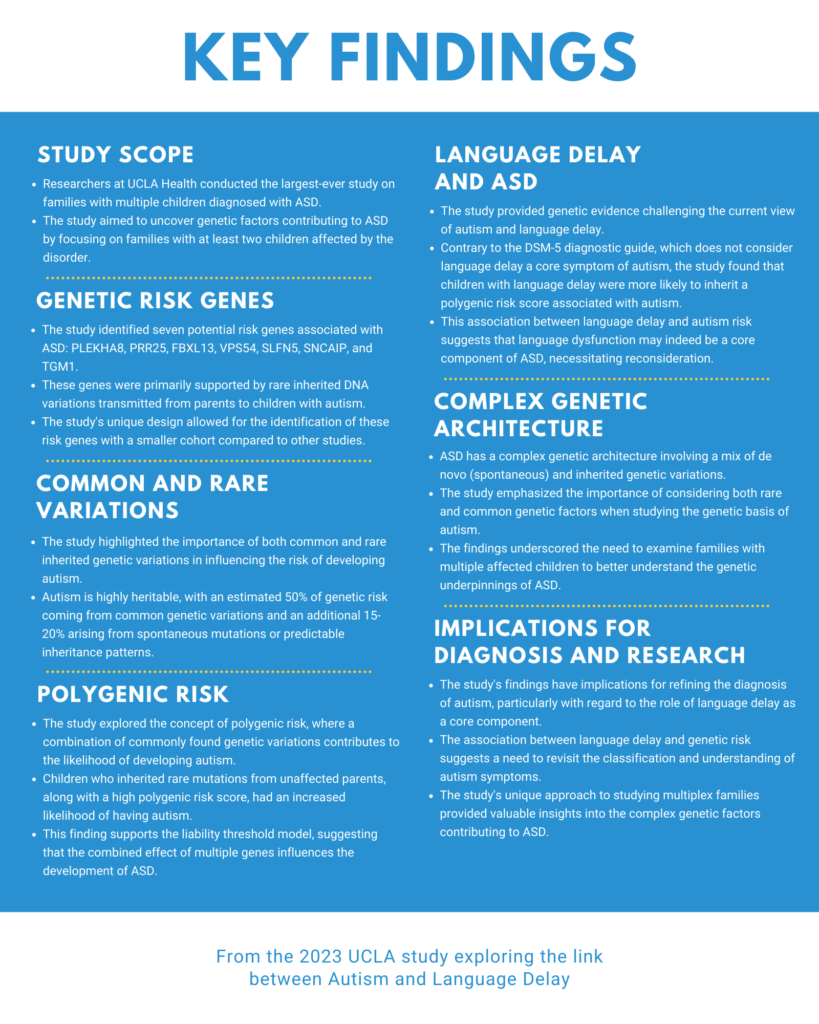UCLA researchers have uncovered seven risk genes for autism in the largest study of families with multiple affected children. Genetic evidence challenges DSM-5, suggesting language delay is a core aspect of autism spectrum disorder (ASD). Polygenic risk and rare inherited variations also play a role in autism development.
Analysis
The article discusses a groundbreaking study by UCLA Health researchers that investigates the genetic influences on ASD development. The study, listed as the largest ever of its kind, focuses on families with multiple children diagnosed with autism and identifies seven potential risk genes. The research challenges current understandings of ASD by providing genetic evidence that language delay should be reconsidered as a key aspect of ASD. The study emphasizes the interplay between common and rare genetic variations in determining autism risk. It also reveals insights into how both inherited and spontaneous genetic mutations contribute to ASD susceptibility. Notably, the research highlights the need to study families with multiple affected children for a more comprehensive understanding of autism’s genetic underpinnings.
The majority of genetic investigations into autism have centered on families with a single affected child, often omitting those with multiple diagnosed children. Consequently, only a limited number of studies have explored the impact of less commonly inherited genetic differences and how they interact with the cumulative influence of multiple genetic variations.
“Study design is critical and not enough attention has been paid to studying families with more than one affected child,” shared lead study author Dr. Daniel Geschwind, the Gordon and Virginia MacDonald Distinguished Professor of Human Genetics, Neurology and Psychiatry at UCLA.
Key Findings
The study includes several key findings that help to capture the scope of the groundbreaking research:

Overall, the study significantly advances the understanding of the genetic factors involved in ASD, highlighting the interplay between common and rare genetic variations and challenging existing notions about language delay as a core feature of the disorder.
Additional Research
The UCLA research team is in good company in their research efforts. According to a study by the Centers for Disease Control and Prevention (CDC), the prevalence of ASD among American children has increased between 2018 – 2020. In 2020, around 1 in 36 8-year-olds were estimated to have autism, compared to one in 44 in 2018. While this increase may not directly indicate that autism has become more common, it highlights the importance of increased awareness and improved screening that might be contributing to the new data. The prevalence was higher in boys (approximately 4%) compared to girls (around 1%). Notably, the prevalence increase was more pronounced among Black, Hispanic, and Asian or Pacific Islander children, potentially due to improved screening, awareness, and access to services.
The study was based on data from the Autism and Developmental Disabilities Monitoring Network, which has tracked autism prevalence in communities across the United States since 2000. The network’s data has shown a consistent increase in autism prevalence since 2000, when approximately 1 in 150 8-year-olds were estimated to have autism.
To read the full 2023 UCLA study, click here.
Sources:
https://neurosciencenews.com/autism-genetics-language-23729/
https://www.pnas.org/doi/10.1073/pnas.2215632120
https://www.cdc.gov/media/releases/2023/p0323-autism.html

